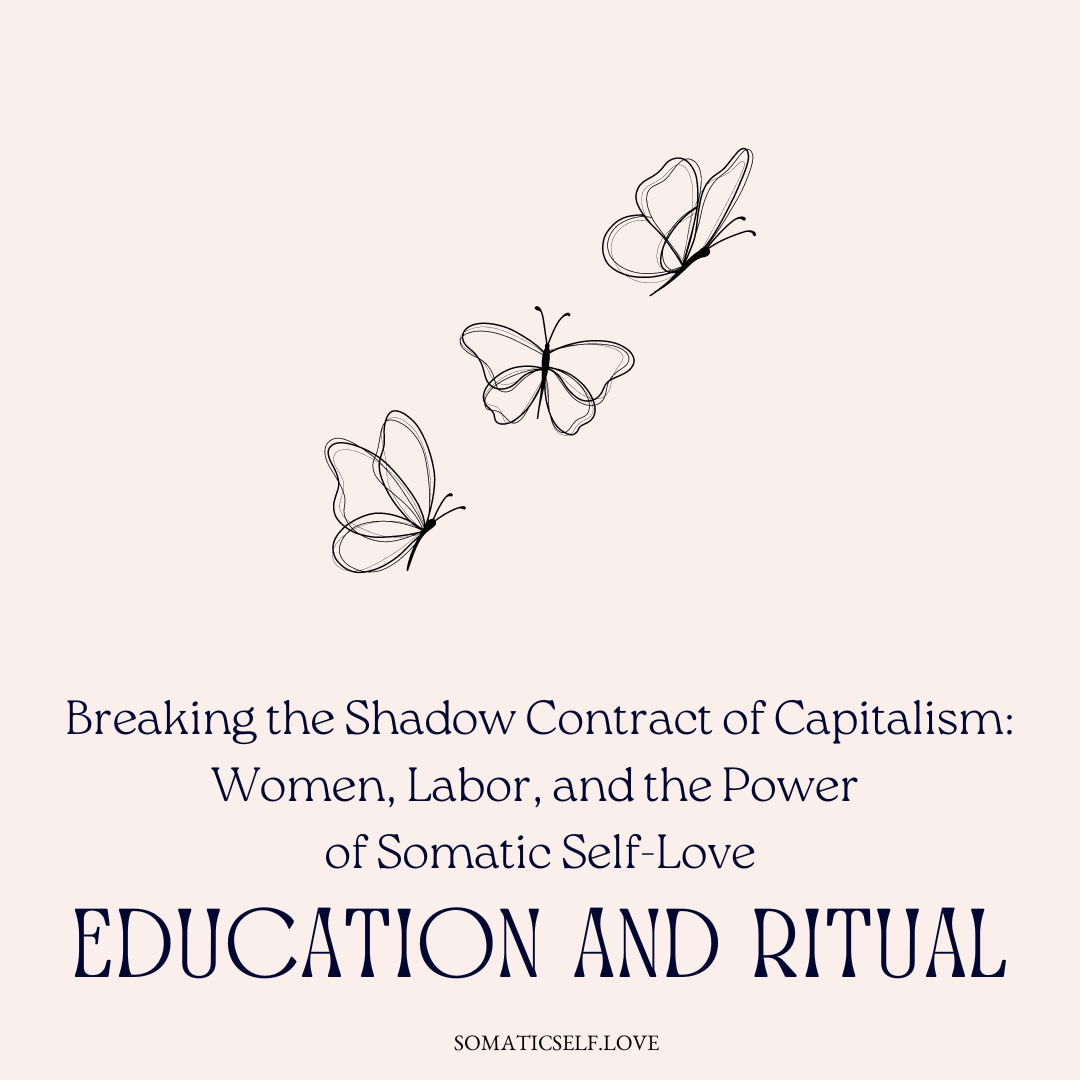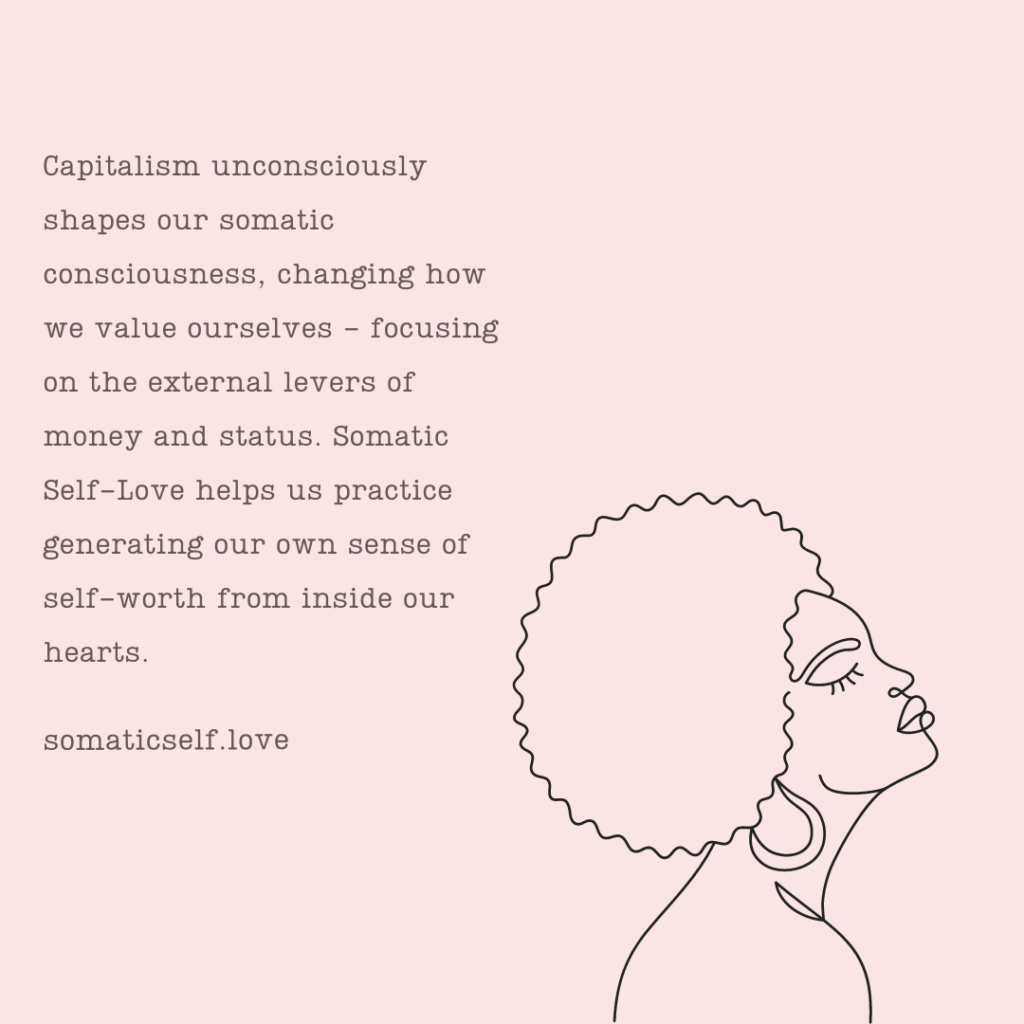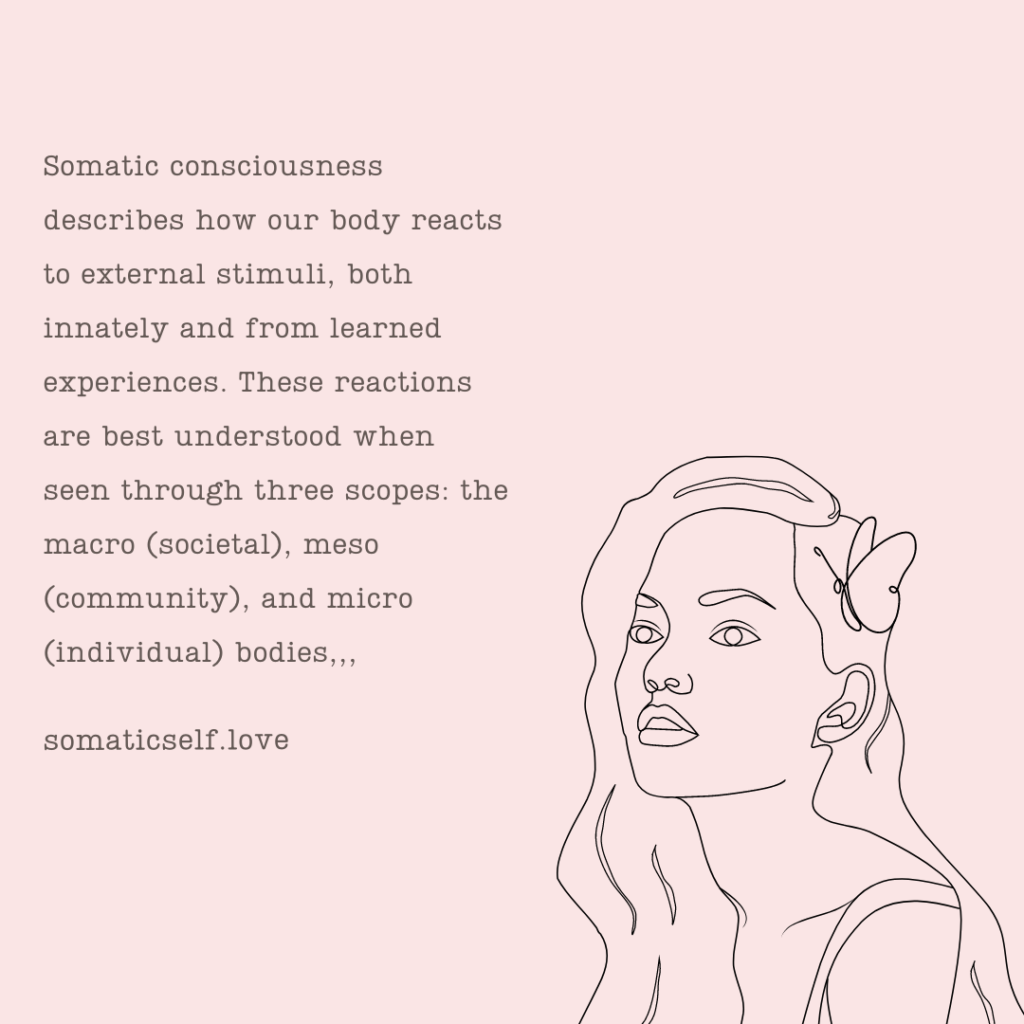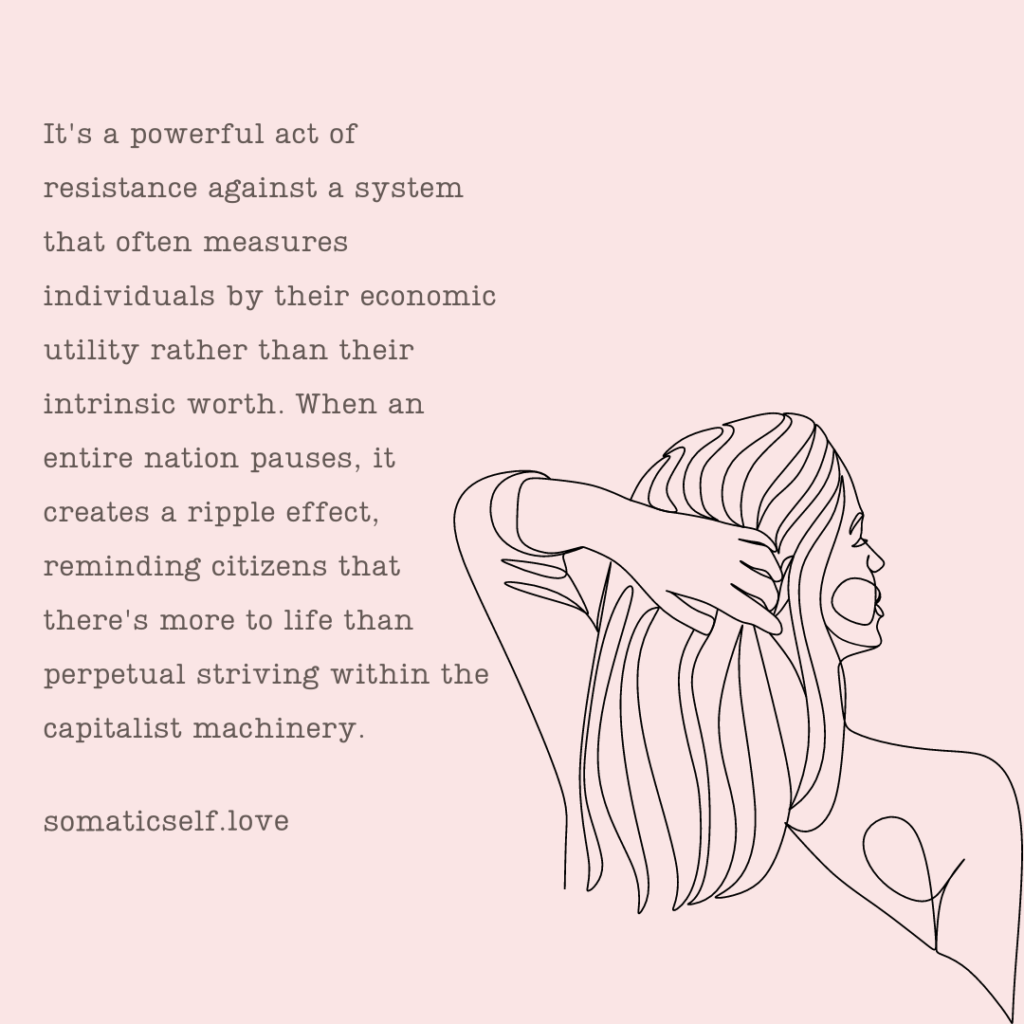Breaking the Shadow Contract of Capitalism: Women, Labor, and the Power of Somatic Self-Love

Underneath the veneer of prosperity and progress, there are shadow sides of capitalism: a system that has, over time, objectified human worth. Especially around the freedom and empowerment of women. As we enter into the portal of another Labor Day weekend, it’s time to reflect on this narrative and the collective spells of equating self-worth with money and status.
The Grief of Capitalism
With its promise of economic growth and opportunity Capitalism has brought its benefits. And, the relentless drive for profit has also led to a commodification of human value. The correlation between our economic output and our worth as a human being has been deeply ingrained into the macro, miso and micro levels of our somatic consciousness.

Research tells us that capitalist societies embody the idea that economic productivity equates to personal value – evidenced in the way that success is often exclusively defined by monetary gain, corporate hierarchies, and material accumulations.
A study by Kasser, T., & Ryan, R. M. (1993) titled “A dark side of the American dream: Correlates of financial success as a central life aspiration” in the Journal of Personality and Social Psychology sheds light on how aspirations centered on financial success can be detrimental to well-being and self-actualization.
Somatic Consciousness In the Different Bodies
Somatic consciousness describes how our body reacts to external stimuli, both innately and from learned experiences. These reactions are best understood when seen through three scopes: the macro (societal), meso (community), and micro (individual) levels.
Macro Level – The Societal Body
Here, somatic consciousness is a reflection of broad societal and cultural values, beliefs, and traumas. Imagine an entire nation’s collective physical reaction during their national anthem; that’s the societal body in motion.
Key Takeaway: Societies share a collective ‘body language’ based on historical and cultural events. Whether it’s the communal grief from war or the shared joy in a national celebration, societies have collective embodied experiences.
Meso Level – The Community’s Pulse
This level focuses on sub-groups within society, like organizations or smaller communities. Consider the synchronized movements of a local dance group or the shared tension in an overworked office – that’s the meso-level pulse.
Key Takeaway: Smaller groups within a society, driven by shared experiences or norms, develop their own unique somatic patterns. These patterns often resonate with the rhythms of their shared experiences, rituals, and values.
Micro Level – The Personal Rhythm
The most intimate scale, this is about individual embodiment. Think about the individual rush of adrenaline from a personal fear or the warmth one feels from a compliment. This level represents our personal rhythm in response to life’s beats.
Key Takeaway: Each person has a unique dance of emotions and reactions that plays out in their bodies. These are shaped by personal experiences, traumas, and joys.
Imagine a ripple in a pond. At the point of impact (micro), it’s intense and personal. As the ripple spreads outwards (meso), it encompasses more of the pond, reflecting shared dynamics of smaller groups.
Eventually, the ripple reaches the pond’s edge (macro), having an effect on the entire body of water, showcasing a broader, collective movement.
Our bodily reactions to external stimuli are not just personal. They’re intertwined with the communities we’re part of and the larger society we live in. Recognizing this interconnectedness helps us understand our reactions better and emphasizes the significance of communal and societal influences on our individual bodies.
Body Loops Across Levels
A body loop is a term in Somatic Self-Love, encapsulating the deeply entwined interactions between memories, emotions, neurochemical stores and somatic (body-based) experiences. Stemming from past experiences (especially developmental abuse and trauma), these patterns represent reflexive emotional, physiological, and psychological responses that shape our present behavior, emotions, and decisions. Body loops highlight how our bodies retain and replay the past influencing our ongoing relationship with ourselves and our environment.

Body loops create somatic consciousness and there is an intricate interplay between body loops, somatic consciousness and the different “bodies”. This repetitive cycle, connecting our memories, emotions, and bodily experiences, shapes how we interact with the world at the macro (society), meso (community), and micro (individual).
- Macro: At the societal scale, body loops can be seen in shared reactions or behaviors of larger groups. For instance, collective rituals like national anthems or shared mourning during significant events.
- Meso: Within communities or organizations, body loops could manifest as shared practices or routines. An example could be a team’s routine to manage stress or a community’s dance to celebrate.
- Micro: On an individual scale, body loops are deeply personal. They’re the repeated patterns of behaviors, thoughts, and feelings an individual goes through in response to specific stimuli. This might involve habitual ways of sitting, moving, or even responding to certain emotions.
The relentless drive of capitalism influences this somatic consciousness, creating a bodily and mental reaction (body loop) to the pressures of commodified worth. Levine, P. A. (2010) in his work “In an Unspoken Voice: How the Body Releases Trauma and Restores Goodness” touches upon how societal pressures, including those resulting from capitalist constructs, manifest within our bodies, influencing our behaviors, reactions, and overall well-being.
Capitalism, with its persistent emphasis on commodification, casts its own influence on our somatic consciousness. It adds another layer to the body loop, altering how we perceive our own worth and inducing both physical and psychological reactions in response. Levine’s insights help shed light on how such societal structures not only shape society but resonate deeply within our individual and communal bodies, affecting our overall well-being.
Commodification at Different Levels
The commodification of human worth has seeped into various levels of our somatic consciousness as well.
- Macro level: At a societal scale, wealth and economic productivity are often considered primary metrics of a nation’s success, sidelining other crucial aspects such as well-being, education, and health.
- Meso level: Within organizational and community structures, individuals are often valued based on their economic output. Their worth within the organization can often be boiled down to their contribution to profits. This is evident in the wage disparities often seen across job roles, even when the intrinsic value of roles (for example, caregivers vs. CEOs) can be debated (Piketty, T. (2014). “Capital in the Twenty-First Century”).
- Micro level: On a personal level, we internalize these societal values, often judging our self-worth based on economic status, leading to a range of mental health issues. A study by Twenge, J. M., & Campbell, W. K. (2002) in the Journal of Personality and Social Psychology titled “Self-esteem and socioeconomic status: A meta-analytic review” reflects on the intimate link between self-worth and socioeconomic status.
A study by Kasser and Ryan (1993) found that individuals who placed a higher emphasis on wealth, status, and image tended to have lower well-being and more psychological distress. This finding underscores the deep-rooted grief of capitalism: the alienation of people from their intrinsic worth.
Capitalism has been a significant driver of economic growth globally, raising living standards and leading to technological and medical advancements. And, this growth often comes at the expense of wealth distribution.
Why is Wealth Distribution So Important?
Wealth tends to get concentrated among a small elite, leading to significant income disparities.
The study by Blau and Kahn (2007) titled “The Gender Pay Gap” in “The Economists’ Voice” specifically addresses the wage disparities between men and women.
The research delves into factors contributing to this gap, such as occupational segregation, differences in work experience due to caregiving roles, education choices, and potential direct labor market discrimination. The gender pay gap not only impacts women’s lifetime earnings and wealth accumulation but also has broader societal implications on power dynamics and family decisions.
Wealth and income often correlate with power dynamics in society. A pay gap can translate to women having less economic power, which can affect household dynamics, representation in leadership roles, and even policy-making.
Women: Breeders for War and Factories?
Women have borne a significant brunt of capitalism’s dehumanizing effects. Historically, they have been viewed through a dual lens: as reproducers and as laborers. Their value has often been tied to their ability to birth and raise the next generation of workers or soldiers and to serve as compliant workers themselves.
Silvia Federici, in her seminal work “Caliban and the Witch,” argues that the witch hunts in Europe were, in part, an attempt to control women’s reproductive capabilities and turn them into “breeders” to serve the needs of a burgeoning capitalist system. Furthermore, the industrial era saw women being funneled into factories, often working in deplorable conditions for meager wages. Their roles were not determined by passion or aspiration but by a system that saw them as replaceable gears.
Labor Day Reflections: Breaking the Collective Spell
Labor Day weekend offers a invitation to see that our value as individuals transcends economic output or societal roles. The true task is breaking free from the collective spell of seeking external validation through wealth and status.
A study by Twenge and Kasser (2013) highlighted the increasing importance of extrinsic values (like money and status) over the years, noting that this shift might be contributing to higher levels of mental health issues in younger generations. This underscores the urgent need to shift our collective consciousness.
The Portal to Shift Our Body Loops and the Ripple Effect
In a world dominated by 24/7 productivity and the conflation of self-worth with work output, this weekend provides an essential counter-narrative. It serves as a collective breath, allowing an entire nation to step back, momentarily disentangle from the ceaseless cycle of production and consumption, and reflect upon deeper human values. The very essence of taking a day off is the antithesis to the never-ending capitalist drive, offering the needed message: there is power in rest.
A Foundation to Somatic Self-Love: Working Inside Out
The idea that change begins within isn’t new, but it’s crucial now more than ever. Labor Day weekend, often recognized as a time of relaxation and end-of-summer celebrations, represents a deeper, symbolic act. It reminds us that when we take a step back at a micro level – individually or within smaller communities – we begin to influence the larger macro structures around us. This is the essence of the ripple effect: seemingly small, localized changes can lead to vast, widespread outcomes.
The Micro Level: Embodied Changes and Introspection
As defined above, we all have a series of ‘body loops’ or patterns of behaviors, thoughts, and feelings that are deeply ingrained and repeated. Over time, driven by societal expectations and the pressures of capitalism, these loops can become rigid and automatic, making us feel disconnected from our true selves.
When we pause, as we do on Labor Day, we give ourselves an opportunity to name, track and accept these loops. It’s a chance to introspect, to ask ourselves: Are we merely existing within the capitalist machinery, or are we leading purposeful lives aligned with our inner values?
This micro-level engagement isn’t just about self-reflection; it’s about taking active steps towards self-awareness and self-change. By resetting our body loops, by choosing to value ourselves beyond our economic outputs, we begin to embody a different narrative.
Rippling Out to the Macro: Collective Consciousness and Societal Shifts
The beauty of the ripple effect lies in its amplification. When one person starts to redefine their worth, they influence those around them: family, friends, and colleagues. As more and more individuals within a community start to detach their self-worth from relentless productivity, a collective consciousness begins to form. This shared understanding, rooted in intrinsic human values, begins to challenge the dominant capitalist narrative.
Over time, as these micro-level changes coalesce, they gain the potential to influence larger structures. Businesses might start valuing employee well-being over relentless output; governments might implement policies focusing on holistic well-being rather than just economic growth. The ripple can even extend to global structures, prompting a re-evaluation of the metrics we use to measure success.
The Power of a Single Day: Spell Breakers
How can a single day, like Labor Day, incite such widespread change? The answer lies in its symbolism. Labor Day isn’t just a day off from work; it’s a day that honors the rights and values of workers. It’s a day that reminds us that the human spirit isn’t defined by capitalist output. And when an entire nation collectively takes a breath, the collective energy has the potential to break spells.

It’s a powerful act of resistance against a system that often measures individuals by their economic utility rather than their intrinsic worth. When an entire nation pauses, it creates a ripple effect, reminding citizens that there’s more to life than perpetual striving within the capitalist machinery. It’s an opportunity to recalibrate, to question the metrics by which we evaluate success, and to ponder the societal structures that disproportionately favor wealth accumulation at the expense of holistic well-being.
This pause is an invitation to acknowledge and appreciate the intangible aspects of life — connections, memories, emotions, and shared experiences — which often get sidelined in the race for materialistic achievements. Labor Day, in its quiet rebellion, nudges society to reassess the scales of value and consider whether the relentless pursuit of capitalist markers truly aligns with personal and collective aspirations.
By engaging with our inner loops and making micro-level shifts, we can start ripples that have the potential to reshape our society’s very fabric. The journey from the individual to the collective, from the micro to the macro, is one of hope, introspection, and transformation.
Somatic Self-Love: A Path to Inner Validation
At the heart of this transformation lies the practice of somatic self-love. It’s a path that encourages us to reconnect with our bodies, to listen to its wisdom, and to derive self-worth from within.
Research by Payne, Levine, and Crane-Godreau (2015) has demonstrated the benefits of somatic practices in improving emotional regulation, reducing symptoms of depression, and enhancing overall well-being4. By turning inwards and fostering a deep sense of self-love, we begin to decouple our sense of worth from external markers, laying the foundation for a more holistic and sustainable sense of validation.
Ritual: Cultivating Self-Worth from Within
As we approach Labor Day weekend, let’s engage in a ritual that anchors us in somatic self-love, celebrating our intrinsic worth:
- Setting Intentions: Find a quiet space, free from distractions. Light a candle or incense, symbolizing the light of self-awareness and love. Set your intention, perhaps something like: “I am more than my societal roles or economic output. My worth emanates from within.”
- Breathing into Worthiness: Sit or lie down comfortably. Take deep, grounding breaths. With each inhalation, imagine drawing in self-love and worthiness. With each exhalation, release any beliefs of inadequacy or external validation.
- Heart Connection: Place both hands on your heart, feeling its rhythm. Affirm to yourself: “I am enough. My worth is inherent.”
- Body Scan Meditation: Slowly move your awareness from the tips of your toes to the crown of your head. As you do this, express gratitude to each part of your body, recognizing its unique value and contributions.
- Anchor in Self-Worth: Visualize a radiant sphere of light in your heart center, symbolizing your intrinsic worth. Let this light expand, enveloping your entire being.
- Closing the Ritual: Slowly bring your awareness back to your surroundings. Express gratitude for this moment of connection and the journey ahead.
While capitalism and societal narratives have, for long, dictated our worth, the power to redefine and reclaim it lies within us. Through practices like somatic self-love, we can cultivate a profound sense of inner validation, leading us to not only heal individually but to also pave the way for collective healing.
References
- Kasser, T., & Ryan, R. M. (1993). A dark side of the American dream: Correlates of financial success as a central life aspiration. Journal of Personality and Social Psychology, 65(2), 410–422.
- Piketty, T. (2014). Capital in the Twenty-First Century. Belknap Press.
- Twenge, J. M., & Kasser, T. (2013). Generational changes in materialism and work centrality, 1976–2007: Associations with temporal changes in societal insecurity and materialistic role modeling. Personality and Social Psychology Bulletin, 39(7), 883–897.
- Twenge, J. M., & Campbell, W. K. (2002). Self-esteem and socioeconomic status: A meta-analytic review. Journal of Personality and Social Psychology, 72(1), 1–12.
- Levine, P. A. (2010). In an Unspoken Voice: How the Body Releases Trauma and Restores Goodness. North Atlantic Books.
- Blau, F. D., & Kahn, L. M. (2007). The gender pay gap. The Economists’ Voice, 4(4).
- Federici, S. (2004). Caliban and the Witch: Women, the Body and Primitive Accumulation. Autonomedia.
- Payne, P., Levine, P. A., & Crane-Godreau, M. A. (2015). Somatic experiencing: Using interoception and proprioception as core elements of trauma therapy. Frontiers in psychology, 6, 93.